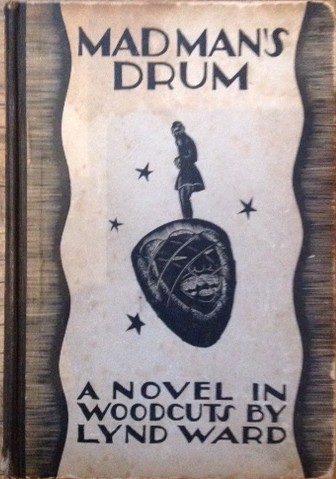Inspiring Older Readers
 posted on 30 Jan 2022
posted on 30 Jan 2022
Madman’s Drum: a novel in woodcuts by Lynd Ward
American artist, Lynd Ward (1905 – 1985) was a master of the woodcut print and it’s quite possible you will have seen his distinctive black and white illustrations gracing the pages of classic novels, including Mary Shelley and Oscar Wilde.
Born in Chicago into a Methodist family, his father instilled a radical, socially progressive attitude in Lynd who went off to study wood engraving in Leipzig for a year on what was an extended honeymoon. It was at this time that he encountered the work of Frans Masereel who was developing his own version of the wordless novel. Inspired by Masereel’s experiments, Ward returned to America and discovered the only work of another German, Otto Nückel whose wordless book, Destiny, told the sympathetic story of a prostitute, whom he paints as a victim of an exploitative society.
This prompted Ward to see the wordless novel as a potentially powerful medium for evangelising his progressive political views and he produced the first of what would be six books without words in 1929 which he called Gods’ Man. This first book was a success and sold well, convincing him to move on to the next in the series, Madman’s Drum, in 1930.
The story Ward tells in this wordless book is essentially a morality tale based around the idea that the sins of the father will be visited on his children. In this case a slave trader appropriates a demon-faced drum from an African he has killed and as the slaver’s fortune and social standing thrive, the drum and the sword he used to kill the African are kept on his wall as trophies.
The slaver’s son is banned from playing with the drum and sword and instead is forced to study hard – which he does to the detriment of his social life. The slaver dies at sea on a return to Africa and the boy, who has rejected Christianity, accidently kills his own mother when she trips on a crucifix he has carelessly tossed to the floor.
The boy grows up to become a successful scientist but is emotionally cold towards his eventual wife and family - all of whom suffer various grizzly fates involving suicide, adultery and depression. All of this tragedy eventually drives him insane and he is doomed to wander abroad with the devilish drum that he plays with a similarly devilish piper who has been shadowing him for years.
The narrative of the story is relatively simple and clear despite the lack of words but the complexity and ambiguity lies in the extraordinary subtlety of the drawings that are full of nuance and are open to interpretation. It’s a story that read several times just keeps on revealing detail and character development that you might not have noticed the first time around. The dense black and white woodcut format looks limiting but Ward’s skill is such that it enables him to create an atmospheric, three-dimensional narrative that keeps providing an ever changing flow of ideas.
Madman’s Drum wasn’t as commercially successful as his first offering, God’s Man but I think that modern readers of graphic novels will find his work easier to tune into than those of us brought up on more traditional novel fare. I have to say that I find the whole genre of the woodcut-based wordless novel one I admire from an artistic or aesthetic perspective rather than for their storytelling power but, if you are an aficionado of graphic novels or adult comic art, this is one you should check out.
Striking paperback reprints are available for under £15 and you can also buy a collection of Ward’s six novel wordless book cycle for a modest £25 or so.
Terry Potter
January 2022



